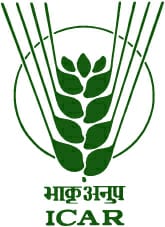Mungbean
Mungbean is a native Indian crop that is also referred to as green gram or moong. In addition to being an important food and economic crop in the rice-based farming systems of South and Southeast Asia, However, it is also grown in other regions of the world. The average production of mungbeans is 721 kg/ha, and there are around 7.3 million hectares planted worldwide. 30% of the 5.3 million tonnes of production produced globally is split between India and Myanmar. China, Indonesia, Thailand, Kenya, and Tanzania are other significant producers (Nair et al. 2020). Mungbean production in India is expected to total 5.5 million hectares in 2022, yielding 3.17 million tonnes at a productivity of 570 kg/ha. The Mungbean alone accounts for 10% of production and 16% of area for all pulses. The dominant contributors to mungbean cultivation in terms of area and production are Rajasthan (46% and 45% respectively), with Madhya Pradesh (9% and 14%), Maharashtra (9% and 8%), Karnataka (9% and 6%), Odisha (5% and 4%), Bihar (4% and 5%), Tamil Nadu (4% and 3%), Gujarat (3% and 4%), Andhra Pradesh (3% for both), and Telangana (2% for both) also playing significant roles, as stated in the Annual Report (2022-23) by AICRPR on Kharif pulses. The mungbean market is segmented into four primary segments based on its diverse applications, including dry grains (prominent in South Asia and Kenya), sprouts (popular in East and Southeast Asia), transparent noodles/starch (high demand in East and Southeast Asia), and paste (preferred in East Asia). In 2021, the Global Mung Beans Market recorded a revenue of approximately USD 3,787.83 million, and it is projected to exhibit a Compound Annual Growth Rate (CAGR) of over 3.31% from 2021 to 2028, reaching approximately USD 4,757.59 million by 2028. Moreover, the cumulative growth opportunity presented by the global Mung Beans market is estimated to be around USD 30.25 billion during the period from 2022 to 2028. Mungbean holds diverse applications across different regions, where specific varieties may be required. The most prevalent utilization of mungbean worldwide is in the form of dry grains used in cooking. In South Asia (India, Pakistan, Bangladesh, and Nepal), mungbean grains are commonly consumed as dahl, which is a stew prepared with dried pulses. In Kenya, mungbean is primarily consumed as a hearty bean stew. In other nations, mungbean grains are prepared in various ways such as cooking them with rice, sweetening them to create a dessert soup (e.g., in China), or grilling/roasting them for a snack. It is particularly well-suited for sprouting, a common practice in East Asia and Southeast Asia. The major countries contributing to mungbean imports (96% total) are Kenya (30%), followed by Mozambique (24%), Tanzania Rep (18%), Brazil (11%), UAE (4%), Australia (3%), South Africa (2%), Uganda (2%), and Venezuela (2%). As for mungbean export destinations, the key countries are the USA (24%), Nepal (18%), UK (18%), Canada (10%), Bangladesh (6%), Qatar (4%), Netherlands (4%), Australia (2%), UAE (2%), and Malaysia (2%). The average global grain yields of mungbean are relatively low at 0.73 t/ha, indicating substantial potential for the development of higher-performing varieties.
For decades, international cooperation has played a vital role in mungbean breeding research. To enhance this collaboration in response to future global challenges related to nutrition security and climate change, the World Vegetable Center took the initiative in 2016 to establish the International Mungbean Improvement Network (IMIN). This network involves several mungbean-growing countries, including India, and was made possible with the financial support provided by the Australian Centre for International Agricultural Research (ACIAR).





